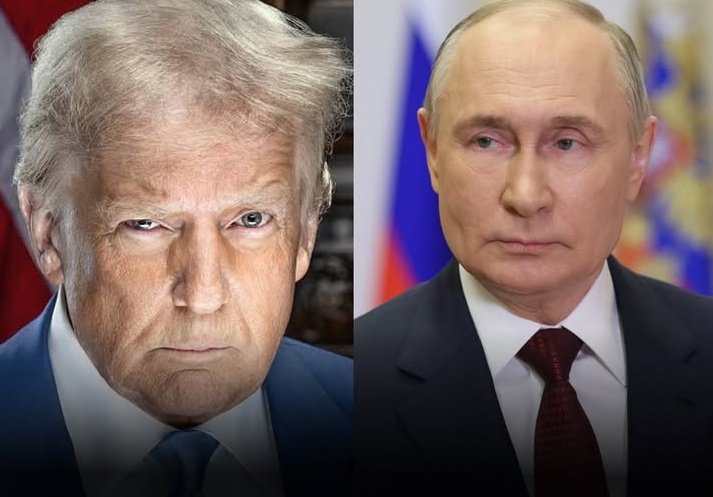
Trump and Putin Face Off in Alaska: A Historic Meeting with the Weight of War Hanging in the Balance

The icy chill of Anchorage, Alaska, became the backdrop for one of the most consequential diplomatic encounters of the decade as U.S. President Donald Trump and Russian President Vladimir Putin met face-to-face for the first time since Russia’s full-scale invasion of Ukraine. The summit, held at Joint Base Elmendorf-Richardson on Friday, carried with it the weight of global anxieties, fragile hopes, and the unmistakable tension of two leaders whose personal chemistry has long fascinated and unsettled the international community. It was a moment scripted in history books before the first handshake even happened, as cameras flashed furiously while Trump and Putin locked eyes and exchanged a firm grip, their faces betraying none of the stakes at hand.
For Trump, the meeting was a political and diplomatic gamble. Since returning to the White House, he has been vocal about his determination to broker what he has often described as “the deal of the century,” one that could bring an end to the war in Ukraine that has devastated Europe, drained NATO resources, and scarred global stability. Yet, despite months of signaling openness to negotiations, Trump’s decision to exclude Ukrainian President Volodymyr Zelensky from the Alaska talks raised eyebrows across Washington and European capitals. Critics accused Trump of sidelining Ukraine in discussions that concern its sovereignty and survival, while supporters insisted that the president’s unorthodox style could yield results traditional diplomacy has failed to achieve.
“This is really a feel-out meeting,” Trump had told reporters earlier in the week, projecting his signature confidence. “Probably in the first two minutes I’ll know exactly whether or not a deal can be made.” His words echoed the businessman-turned-president persona he has long cultivated, where gut instincts and bold declarations take precedence over cautious diplomacy. But behind the bravado, administration officials quietly acknowledged that expectations for a breakthrough were modest at best.
Putin’s presence on U.S. soil was itself a striking spectacle. Since launching the invasion of Ukraine in 2022, the Russian leader has been largely ostracized by Western governments, painted as a pariah responsible for the bloodshed of a brutal conflict that has claimed hundreds of thousands of lives. Yet here he was, welcomed to America’s northern frontier, signaling not only a potential thaw but also the hard reality that Russia’s war could not be wished away or defeated by sanctions alone. For Putin, the summit offered a rare chance to project legitimacy, to show Russians back home that he remained a global player capable of negotiating directly with Washington despite years of isolation.
Meanwhile, the battlefield told a starkly different story. On the very eve of the meeting, Ukrainian officials reported a new wave of Russian drone strikes that killed seven civilians and injured seventeen others. Images of smoldering ruins in central Ukraine underscored the ongoing brutality of a war that has defied ceasefire talks and peace initiatives for more than three years. To many Ukrainians, the idea of Trump and Putin negotiating without Zelensky at the table felt like a betrayal, a return to the great-power politics of old where smaller nations were treated as pawns on a chessboard.
Yet Trump pressed forward, framing the Alaska summit as a test of Putin’s willingness to end hostilities. The U.S. president issued what he described as a stern warning: “There will be very severe consequences if Russia refuses to agree to end this war.” Though he did not specify what those consequences might be, the remark hinted at a readiness to escalate pressure, whether through economic means or military support for Ukraine, if negotiations failed. It was a message carefully calibrated for both domestic and international audiences — a show of toughness meant to reassure skeptics who fear Trump might concede too much to Moscow in his pursuit of a deal.
Inside the closed-door session, aides from both sides waited anxiously as the two leaders spoke in private. The White House offered no immediate readout, and Russian state media provided only vague descriptions of a “constructive atmosphere.” Outside the gates of the military base, a small crowd of protesters gathered, some waving Ukrainian flags and chanting for peace, others carrying placards denouncing both leaders for what they saw as political theater at the expense of human lives.
Diplomatic observers noted that Alaska was a symbolic choice for the meeting. Geographically, it lies between Russia and the continental United States, a literal halfway point between two global powers whose relationship has long oscillated between confrontation and cautious engagement. Historically, Alaska also carries the memory of the U.S. purchase from Russia in 1867, a reminder of the complex ties that bind the two nations despite their sharp ideological divides. By convening there, Trump appeared to be signaling both neutrality and pragmatism — a cold, distant place far from Washington politics or European battlefields, chosen for its symbolism as much as its security.
Reactions from global capitals were swift and mixed. In Kyiv, Zelensky’s government issued a terse statement emphasizing that “no decisions about Ukraine can be made without Ukraine.” In Brussels, NATO leaders expressed cautious support for dialogue but reiterated that any peace agreement must uphold Ukraine’s territorial integrity. Meanwhile, Beijing, ever watchful of shifts in U.S.-Russia dynamics, remained silent but no doubt attentive to how the Alaska talks might affect its own strategic calculations.
As night fell in Anchorage, the world waited for signs of progress, but the mood was more one of suspense than celebration. Diplomacy at this level is rarely resolved in a single meeting, and most experts predicted that Trump and Putin’s encounter would mark only the beginning of a longer and more grueling process. Still, the mere fact that the leaders had met in person — after years of war, sanctions, and mutual recriminations — was itself historic.
For Trump, success would be defined not just by the cessation of hostilities in Ukraine but also by the political dividends he could reap at home. An American president who delivers peace where others failed would have a powerful narrative to wield in the next election cycle. For Putin, the calculation was equally pragmatic: to use negotiations as a means of easing sanctions, fracturing Western unity, and cementing his image as a statesman rather than an isolated aggressor.
The stakes could not be higher. The war in Ukraine has reshaped the global order, destabilized energy markets, and tested the resilience of democracies across the world. Whether Trump and Putin can bridge their differences and chart a path toward peace remains uncertain, but one thing is clear: the Alaska summit has reignited the world’s attention on a conflict that refuses to fade, reminding all that history is often written not in grand declarations but in tense, guarded conversations behind closed doors.
As the two leaders departed the base under the midnight sun, no joint statement was issued, no ceasefire declared, no peace plan unveiled. Instead, what lingered was the haunting sense of possibility — that perhaps, just perhaps, the first step toward ending one of the bloodiest wars in recent memory had been taken in the icy stillness of Alaska.


